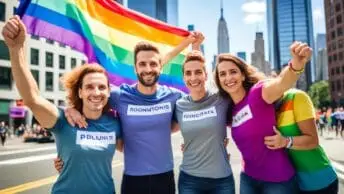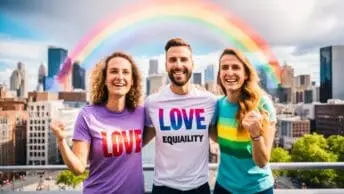What speaks to the LGBTQ+ community? How can brands connect sincerely, avoiding tokenism?
The LGBTQ+ audience in the UK is vibrant and diverse. It has a big economic impact, dubbed the ‘pink pound’, worth about £6 billion each year. The challenge for many brands is to engage this community genuinely. Research shows 72% think most ads only give them token nods.
UK marketing must show real LGBTQ+ lives, much like “Schitt’s Creek” or “Heartstopper”. Genuine stories lead to success among this diverse group. Brands need true commitment to inclusivity for better campaign outcomes.
Year-round LGBTQ+ marketing effort is crucial, not just during LGBTQ History Month. Continuous support shows real allyship. It strengthens bonds with the community and fosters a more inclusive society.
True engagement with the LGBTQ+ crowd asks for an in-depth, real approach. Brands leaning into LGBTQ+ perspectives and celebrating diversity will forge deep connections with this vibrant community.
Understanding the LGBTQ+ Audience
It’s vital for businesses to see the variety in LGBTQ+ communities. This group includes lesbian women, gay men, bisexuals, and transgender individuals. Each person brings their own view and needs.
Effective targeting requires understanding these unique groups. The LGBTQ+ community’s spending power reached $917 billion in the U.S. by 2017. This shows how economically significant they are.
Inclusive language is key to connect with the LGBTQ+ audience. Using gender-neutral pronouns and recognising events like Pride Month genuinely matter. Stoli Vodka has supported LGBTQ events for over 25 years. This shows the value of ongoing engagement, not only during Pride.
Understanding LGBTQ+ identities helps avoid assumptions and stereotypes. Brands need to know that each group, like transgender people or gay men, wants marketing that reflects their real lives.
Brands with LGBTQ+ people in marketing roles show true connection and understanding. This builds trust and loyalty. By catering to each segment’s needs, campaigns become more impactful.
The Importance of Representation
Representation is key in inclusive marketing, very important for the LGBTQ+ community. When media shows our identities, it makes us feel we belong. This helps brands connect better with all their customers.
Now, we see more diversity, like disability, in ads and shows. This push for inclusion shows we value everyone’s story. Barbie, for example, makes sure one in five dolls is Black. This shows the importance of showing all kinds of people in what we buy and watch.
The push for diversity also helps the LGBTQ+ community. Brands should show many different people in a real way. This stops harmful stereotypes and builds a world that accepts everyone. It also makes people feel seen and valued.
Studies say 74% of us like to buy from brands that show who we are. Seeing ourselves in ads makes us loyal to a brand. For example, showing women’s sports changes how we see them. It shows the power of showing everyone’s story.
In the end, including everyone in marketing helps the LGBTQ+ community and others feel seen. True stories create strong connections and trust. It turns out, showing real life isn’t just good for ads. It’s about caring for each other.
Challenges of Tokenism and Stereotypes
Tokenism makes LGBTQ+ marketing tough, leading to unbalanced portrayals. It often turns away the very people brands want to reach. Getting an authentic portrayal means showing a wide range of identities, including lesser-known ones like demisexuality. Authentic marketing is crucial, as ads with diverse casts get more trust and buy-in, a 2019 Nielsen report shows.

Businesses with more diversity have 19% more innovation revenue and 9% higher EBIT margins. This shows diversity’s benefits. Breaking stereotypes is key to avoid clichés, like mainly showing effeminate men or masculine women. Marketing should show the true face of the LGBTQ+ community.
Adding more than one person from each demographic avoids tokenistic portrayals. It builds a more inclusive culture. Companies that boost diversity and inclusion often perform better. This proves that real representation matters in business and marketing.
Effective Strategies for LGBTQ+ Inclusive Marketing
Creating diverse marketing campaigns for the LGBTQ+ community needs careful and inclusive planning. It’s crucial to include LGBTQ+ perspectives in market research inclusivity. This goes beyond just looking at basic data. It explores the various lives and likes within the community. By doing this, we can reach more people, not just some.
Roughly 7.2 percent of Americans identify as LGBTQ+, twice as many since 2013. They often deal with negativity online and feel left out of ads. This shows why companies need to genuinely include them. Around 39 percent of buyers might stop supporting brands that don’t share their values. This highlights the need for inclusivity in marketing.
Great diverse marketing campaigns should avoid cliches and stereotypes. It’s key to truly represent the LGBTQ+ community. They have over $1 trillion to spend in the US. Recognizing all identities, like transgender or bisexual people, helps brands understand their specific needs.
Brands that embrace inclusivity are seen in a better light. Teaming up with LGBTQ+ groups and encouraging open feedback helps make better adverts. By truly including LGBTQ+ perspectives, campaigns can make LGBTQ+ customers feel safe and supported.
Supporting the community is not just for Pride Month. It’s about being inclusive all year. This not only builds loyal customers but also pushes companies to be more creative. It encourages them to see the world through diverse views and experiences.
The Role of Social Media in Inclusive Marketing
Social media helps brands connect with the LGBTQ+ community directly. This allows for the sharing of true LGBTQ+ stories. It’s crucial since 70% of Gen Z like brands more when ads are diverse. And 71% of LGBTQ+ people are more engaged with ads that reflect their identity.
Brands can use social media to get quick feedback on campaigns. This helps them understand and bond with the LGBTQ+ community better. A big 57% of shoppers stay loyal to brands that fight social unfairness.
Social media is a key tool for lifting up rarely heard voices. It challenges old stereotypes by sharing real personal stories. Spaces like Twitter and Instagram give marginalised folks a sense of belonging.
The power of social media in marketing can’t be ignored. It allows brands to teach, raise awareness, and celebrate diverse cultures. Movements like #BlackLivesMatter and #MeToo have grown because of social media.
Now, 83% of marketers see their efforts in making digital marketing more accessible as a positive change. This shows a commitment to being more inclusive. It’s significant because people can call out brands on social media when they’re not inclusive.
Collaborating with LGBTQ+ Influencers
Working with LGBTQ+ influencers who truly connect with their audiences is key to making your brand more inclusive. These partnerships go beyond just selling products. They share real stories and experiences that people can relate to. Also, 60% of customers find content from real users to be the most genuine.

The LGBTQ+ market has a huge buying power of $3.7 trillion. By forming meaningful partnerships with LGBTQ+ influencers, brands can really enhance their image and earn trust. It’s vital to collaborate with a diverse group of influencers. This shows support for the LGBTQ+ community and promotes inclusivity.
Doing your homework before a partnership is just as important. Make sure the influencer’s content and followers match the campaign’s values.
LGBTQ+ influencers are also great for promoting travel destinations. They help increase visibility and trust. It’s also crucial to set goals like engagement rates to measure success. Many successful campaigns work with influencers all year round, not just during Pride month.
Teaming up with LGBTQ+ groups can broaden your campaign’s impact and support a good cause. Paying LGBTQ+ content creators fairly is not only fair but also leads to better outcomes. This approach helps build a stronger connection with the community. It shows that the brand’s support is sincere and lasting.
Supporting LGBTQ+ Events and Sponsorships
Brands show true commitment to the LGBTQ+ community by supporting events and sponsorships. For 19 years, the UK has celebrated LGBTQ+ History Month, started by Schools Out in 2005. These events, including various Pride celebrations, let brands show their support and unity.
The queer community’s spending is estimated at £6bn annually in the UK. Authentic sponsorship can make a big impact. However, it’s important for brands to be genuine. Research shows that 10% of the LGBTQ+ community think brands support Pride Month just for money. And 31% feel these promotions often show them in a bad light. This means companies must be real and avoid “rainbow washing,” like the much pricier Pride-themed Vaseline.
There are many ways to engage positively. MAC’s Viva Glam campaign raised over $500 million for HIV/AIDS. And Coach gave £50 million to LGBTQ+ efforts. Even Proud LGBTQIPA Beer donates 20p for every purchase, showing true support.
Support also means joining in Pride events actively. By participating and giving back, brands can connect deeply with the LGBTQ+ community. This builds loyalty and shows shared values. Such actions send a powerful, inclusive message that goes far beyond marketing.
Internal Company Policies and Culture
Workplaces with good diversity and inclusivity policies help build a strong company culture. Companies that want to connect with the LGBTQ+ community need to improve their policies. Making a supportive environment for LGBTQ+ shows a company’s true commitment to their values.
A study by the Canadian Marketing Association found only 22% of workers think management lives up to its own values. Addressing this gap can change a business for the better.
A positive organisational culture is key. The University of replaced_tag found happy employees are 13% more productive. Adding things like employee advocacy programs can grow inclusivity and even bring new business.
About 45% of those in advocacy programs saw new income sources. Clearly, supporting LGBTQ+ employees is ethical and boosts business performance.
Real diversity policies must be seen every day, not just on paper. Inc. reports 73% of workers are more involved in companies with a purpose. A truly inclusive workplace has real benefits.
Benefits like employee discounts can increase loyalty and engagement. This ensures LGBTQ+ employees feel valued in their jobs.
Measuring the Success of LGBTQ+ Inclusive Marketing Campaigns
LGBTQ+ inclusive marketing campaigns are measured by engagement, sentiment, and loyalty. These measures help brands see how well they connect with LGBTQ+ people. It’s essential to look beyond traditional metrics to truly understand the impact on the LGBTQ+ community.
Brands that support LGBTQ+ causes get more love from consumers. A whopping 57% of consumers stay loyal to brands that fight social inequities. This shows the power of linking marketing with social values. Brands must be authentic and always listen to the community to get better.
Listening to LGBTQ+ folks is key to improving marketing. It allows brands to make their messages more relevant and true. 71% of LGBTQ+ consumers engage more with ads that reflect their real lives. Authentic representation, ongoing dialogue, and smart assessment are the steps to success in LGBTQ+ marketing.
Learning from Mistakes
Learning from digital marketing mistakes is key to better campaigns for the LGBTQ+ community. Brands need to keep improving, especially after big mistakes. Being open to criticism and ready to change is vital.
Talking to the LGBTQ+ community for feedback is crucial. This shows what they need, helps avoid old mistakes, and builds trust. To make campaigns really hit the mark, include their viewpoints.</Resistance to change can block progress and understanding.
Digital marketing must meet various needs, not just one. Trying new strategies can help reach more people. By mixing digital tools and real-world tactics, and picking influencers by audience fit, campaigns become more genuine. Watching where visitors come from helps tweak campaigns, keeping them flexible and relevant.
Social media builds long-term connections with customers. This ongoing interaction points out what to fix to save money. Using special tools to see how mobile usage affects results can make your content better liked.
If not many people stick around on platforms like LinkedIn, it’s time to think creatively. Having fewer than 20% viewers stay suggests needing better content. By sharing these insights with everyone involved, a brand proves its dedication and earns the LGBTQ+ community’s trust.
Improving marketing is about never stopping the search for what works best. Continually testing and refining campaigns turns past mistakes into valuable lessons. This helps create marketing that’s not only more effective but also includes everyone.
Conclusion
Inclusive marketing is more than just a trend; it’s essential for real connection with the LGBTQ+ community. Strategies focused on inclusivity can boost customer loyalty and support for brands by up to 23%. Embracing diversity helps brands grow their market share in the LGBTQ+ community by 15%. These numbers show how important real representation is for both the brand and the customer.
Companies that adopt inclusive marketing see a 20% increase in customer engagement. They also enjoy an 18% increase in conversion rates. This shows the strength of inclusivity in boosting business. The move to online marketing offers great chances to reach more people. Social media, email, and search marketing help connect with the LGBTQ+ community. This builds lasting loyalty.
Embracing inclusive marketing is a continuous journey, needing true commitment. Showing the real lives and hopes of the LGBTQ+ audience makes a brand more genuine. It helps make society more inclusive. Brands that value diversity and promote it in their culture show respect and equality for all. With the right mindset, the potential for LGBTQ+ marketing is huge for brands ready to adapt.






